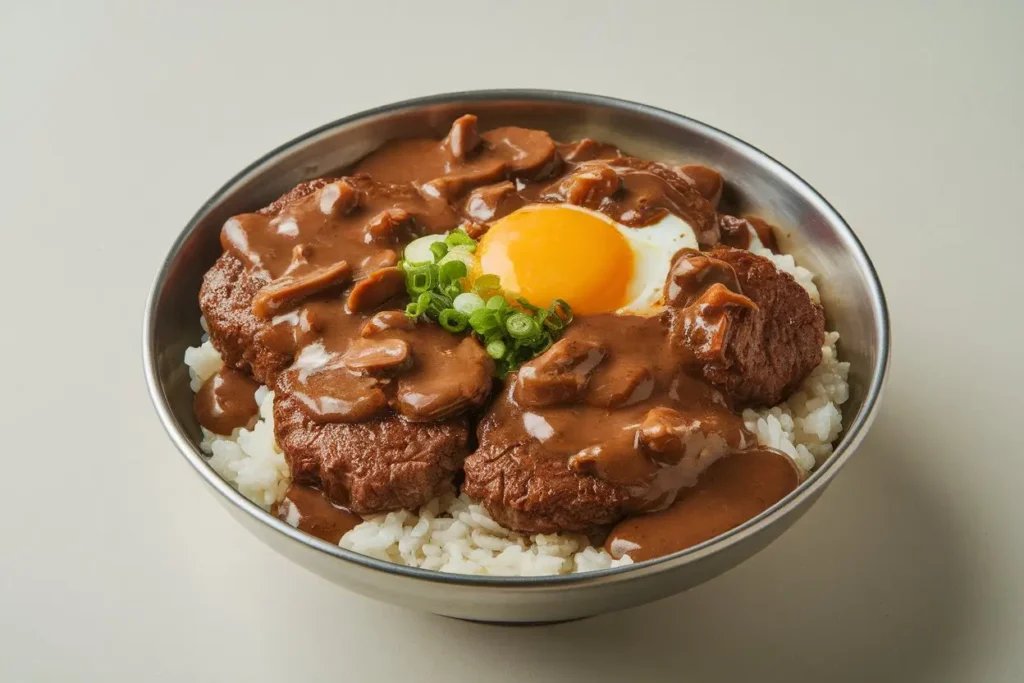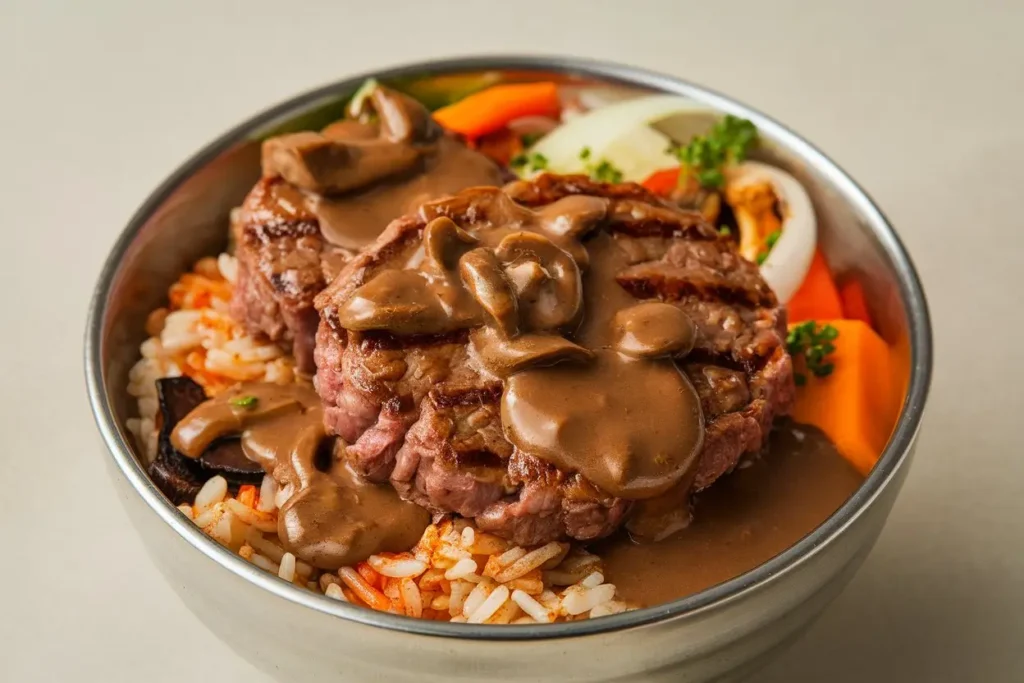Do you believe the perfect steak bowl must be complicated to taste amazing?
Surprisingly, 84% of home cooks shy away from cooking steak rice bowls at home, assuming they’re time-consuming or tricky. Yet, the beauty of a Korean BBQ steak rice bowl lies in its simplicity, adaptability, and explosive flavors. This harmonious blend of marinated beef, sautéed vegetables, and fluffy rice turns a humble meal into a restaurant-worthy experience. With the right techniques, you can enjoy brilliantly balanced Korean BBQ flavors in the comfort of your kitchen—all while saving time and effort. Let’s unravel how Korean BBQ steak rice bowls can become a staple in your kitchen repertoire.
Ingredients List
Creating your own Korean BBQ steak rice bowl starts with handpicking vibrant ingredients that deliver both flavor and texture. Think bold, savory marinades, crisp vegetables, and perfectly grilled beef—all layered over a mound of tender rice. Here’s what you’ll need:
- Steak (Ribeye, sirloin, skirt steak, or even flank for a leaner option) Tip: Marbled cuts offer maximum juiciness
- Short-grain white rice (Jasmine or sushi rice for sticky texture; brown rice, quinoa, or cauliflower rice for healthier alternatives)
- Soy sauce (Low sodium or tamari for gluten-free)
- Sesame oil (Toasted for deep, nutty aroma)
- Garlic (Freshly minced; garlic powder as a backup)
- Ginger (Grated)
- Brown sugar (Honey or coconut nectar as natural swaps)
- Pear or apple (Grated, for classic Korean bulgogi flavor and tenderizing)
- Scallions (Thinly sliced)
- Gochujang (Korean chili paste for authentic heat; sriracha in a pinch)
- Sesame seeds (Lightly toasted)
- Carrots (Julienned)
- Cucumber (Thinly sliced for crunch)
- Pickled radish or kimchi (Optional but highly recommended for zing)
- Eggs (Fried or soft-poached for a rich topping)
- Vegetable oil (For searing the beef)
- Fresh herbs: cilantro or perilla leaves for a herbal pop
Feel free to tailor the add-ins—red bell peppers, spinach, or mushrooms can work beautifully, as can vegan beef substitutes if you’re seeking plant-based versions.
Timing
The preparation and cooking process respects your busy schedule while still delivering culinary value. Here’s a snapshot:
| Stage | Time (minutes) |
|---|---|
| Marinade Preparation | 10 |
| Marinating | 30* |
| Rice Cooking | 20 |
| Beef Searing | 8 |
| Vegetable Prep | 10 |
| Assembly and Garnish | 5 |
| Total Time | 55 |
While 30 minutes is ideal for marinating, even a 10-minute soak delivers punchy flavor. This recipe shaves off total time compared to traditional approaches, which average over 70 minutes.

Step-by-Step Instructions
Step 1: Prep and Marinate the Steak
Begin by slicing your steak thinly across the grain—this guarantees tenderness with every bite. Place slices in a zip-top bag or a shallow dish.
In a mixing bowl, whisk together soy sauce, sesame oil, grated pear, minced garlic, grated ginger, brown sugar, and a generous dollop of gochujang. Pour this marinade over your steak, ensuring each slice is well coated. For the best flavor, marinate for 30 minutes (or as little as 10 if pressed for time).
Tip: Massaging the marinade into the beef with your hands helps it penetrate more evenly.
Step 2: Cook the Rice
While the meat marinates, rinse your rice until the water runs clear—this removes excess starch and keeps things fluffy. Add to a pot (or rice cooker) with water (typically a 1:1.1 ratio for short-grain rice) and cook until fluffy yet sticky. If using brown rice or quinoa, adjust water and cooking times as needed.
Tip: For the perfect rice bowl base, let the rice rest, covered, for 5 minutes after cooking.
Step 3: Sear the Steak
Heat a large skillet or grill pan over high heat. Add a dash of vegetable oil. When shimmering, lay the marinaded steak slices in a single layer. Sear quickly (about 1-2 minutes per side)—you’re aiming for caramelized edges and a tender bite.
Tip: Avoid overcrowding the pan. Cook in batches if needed to achieve a beautiful sear.
Step 4: Prep Toppings
While the steak rests, prep your vegetables. Toss carrots and cucumbers with a splash of rice vinegar and a pinch of salt for a quick pickle. Slice scallions and herbs. If you like, pan-fry eggs so the yolks are gloriously jammy.
Step 5: Assemble Your Bowls
Scoop a generous mound of rice into each bowl. Arrange steak slices on top. Fan out your pickled and fresh vegetables. Slide on a fried egg, scatter sesame seeds, and finish with scallions and a drizzle of extra marinade or a squeeze of gochujang. Layer textures and colors to spark visual excitement.
Tip: Serve with kimchi or pickled radish for zesty contrast.
Nutritional Information
A typical serving (with ribeye, white rice, and a fried egg):
| Component | Calories | Protein (g) | Carbs (g) | Fat (g) | Fiber (g) |
|---|---|---|---|---|---|
| Steak (4 oz) | 230 | 22 | 0 | 15 | 0 |
| Rice (1 cup) | 200 | 4 | 45 | 0.5 | 1 |
| Marinade | 60 | 1 | 12 | 2 | 0 |
| Egg (fried) | 80 | 7 | 1 | 6 | 0 |
| Vegetables* | 50 | 1 | 8 | 0 | 2 |
| Total | 620 | 35 | 66 | 23.5 | 3 |
*Note: Values based on averages; actual numbers may vary by specific ingredients and cooking methods.
- Rich in high-quality protein for muscle repair
- Balanced carbohydrates for sustained energy
- Good fats from eggs and steak
Healthier Alternatives for the Recipe
Swapping ingredients allows you to personalize your bowl and cater to almost any diet or nutritional preference:
- Use lean cuts like flank or sirloin to reduce saturated fat
- Choose brown rice or quinoa for added fiber and antioxidants
- Try cauliflower rice for a lighter, lower-carb option
- Skip the fried egg or swap for a soft-boiled version to reduce fat
- Go plant-based by substituting tofu or tempeh for steak; marinate as you would the meat
- Reduce sodium by using low-sodium soy sauce or tamari, and controlling added salt
- Replace sugar in the marinade with natural sweeteners like honey, or halve the quantity altogether
Vegan kimchi, mushrooms, and even jackfruit can stand in for steak, making the bowl both inclusive and flavorful.
Serving Suggestions
Impress at the dinner table or create a weeknight favorite with these creative serving ideas:
- Layer each bowl “bibimbap-style” with vegetable segments radiating around the steak and rice for eye-catching presentation
- Top with a drizzle of sriracha mayo for extra richness and color
- Pair with seaweed salad or miso soup on the side for a complete meal
- Build a customizable DIY bar with bowls of toppings so guests can personalize their own
- Serve in a heated stone bowl (dolsot) to crisp the rice bottom, evoking a true Korean restaurant feel
Tip: Sprinkling nori strips and extra sesame seeds just before serving boosts both visual appeal and umami.
Common Mistakes to Avoid
Even seasoned cooks sometimes run into pitfalls with steak bowls. Here are a few to sidestep:
- Over-marinating the steak: Anything beyond 24 hours can break down the meat fibers too much, resulting in mushy texture
- Slicing steak the wrong way: Always cut across the grain to maximize tenderness
- Overcrowding the pan: This traps steam and leaves steak gray instead of caramelized
- Skipping rice rinsing: Excess starch can lead to gluey, unappetizing rice
- Neglecting the resting phase: Let steak rest after cooking for juicier results
- Heavy hand with gochujang: It can overpower—add to taste and adjust gradually
Achieving that sought-after balance is just as much about what you don’t do as what you do.
Storing Tips for the Recipe
Leftovers can make tomorrow’s lunch a treat, provided they’re handled well. To maintain peak freshness:
- Cool rice and steak separately to prevent sogginess
- Store in airtight containers in the fridge; rice and steak will last up to 3 days
- Reheat gently: Sprinkle a little water on rice before microwaving to restore moisture; rewarm steak in a hot skillet for a quick sizzle
- Keep fresh toppings and pickles separate; assemble just before eating for crisp textures
- Marinate steak ahead: Store uncooked, marinated steak for up to 24 hours in the fridge, or freeze for future quick meals
Meal preppers will appreciate that all components hold up well when stored properly, making this a flexible “cook once, eat twice” dinner option.
Conclusion
Transforming everyday ingredients into a sensational Korean BBQ steak rice bowl is simpler and quicker than many expect. Grab your favorites, follow these tips, and enjoy the vibrant flavors right at home. Try this recipe, leave a review or comment with your own twists, and subscribe for more fresh, inspired kitchen ideas.
FAQs
Can I use chicken or pork instead of steak? Absolutely. Thinly sliced chicken thighs or pork tenderloin are delicious substitutes—marinade and cook as you would the steak.
I don’t have gochujang. What can I use instead? A mix of sriracha and a little miso paste or soy sauce makes a good stand-in, though it won’t be quite as authentic.
Do I need a grill or can I use a regular pan? A heavy skillet or grill pan on your stovetop works perfectly, ensuring a proper sear without any special equipment.
Can I make these bowls ahead of time? Definitely! Prepare components in advance and assemble just before serving. Reheat rice and steak separately for best results.
Are these bowls gluten-free? They can be! Use tamari instead of soy sauce, and double-check store-bought gochujang for wheat content.
What is the best steak cut for Korean BBQ bowls? Ribeye is prized for its tenderness and flavor, but sirloin or flank steak also perform beautifully, especially if thinly sliced and properly marinated.
How do I keep my vegetables crisp and vibrant? Prepare and store raw or pickled vegetables separately from the hot components, and add to each bowl only when ready to eat.
image
Hungry for more flavor-packed recipes and kitchen wisdom? Explore related dishes like spicy tofu bowls, bibimbap, or quick-pickled sides linked throughout our blog. Your next meal inspiration is just a click away.


